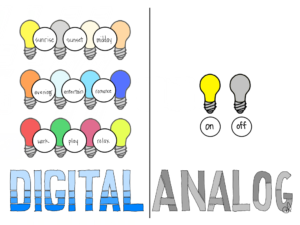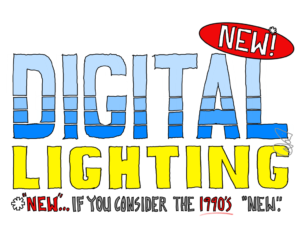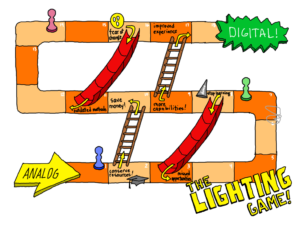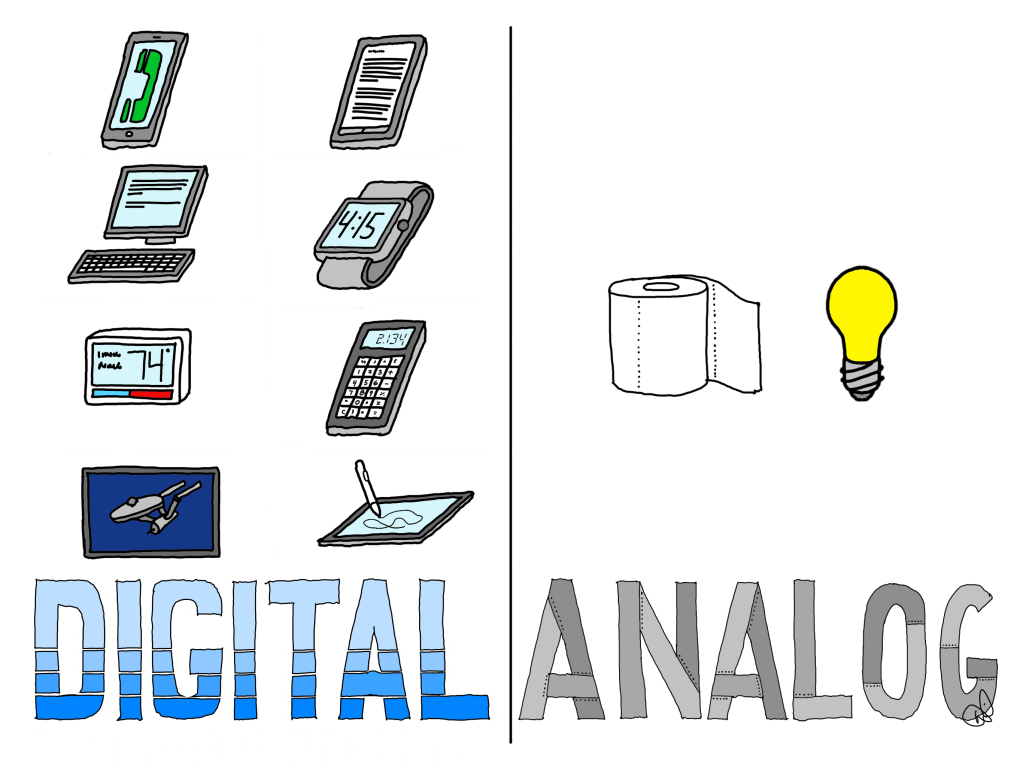So much of our modern lives is digital that we scarcely stumble across the archaic digital versus analog debate. No one uses an abacus in high school math class. Finding a land line to make a phone call is increasingly difficult. Clacking typewriters have given way to silent computers. Some of us wear watches that connect to our phones, the internet, and more. Thermostats give us the indoor temperature, the outside temperature, and allow for precision programming and adjustments.
Gone are the classroom filmstrip projectors and 35mm slide trays. Digital art abounds. I am typing this blog post on a digital device, you are reading it on a digital device, I made the illustrations using a digital advice, and I will get an alert on another digital device if someone posts a comment.
There are some devices, some tools, that remain staunchly analog, but I bet when someone figures out a viable digital alternative to toilet paper, we’ll all be buying Apple iRolls (pronounced eye-rolls, in case you missed it). Lighting seems fixed in this category, a commodity, a utility, a “something-we-need-every-day-and-hope-it-doesn’t-cost-too-much” kind of item.
So lighting, for the most part, remains analog. Buy a light bulb, send it lots of electricity, and it will either turn on or off (or maybe, in some circumstances, dim). Why is lighting not digital?

There are numerous reasons lighting should be digital, but the two I think about the most are For People and For Planet Earth. Digital lighting paradigms- essentially lighting that is controlled electronically rather than manually- opens up a host of features that our analog light bulbs simply cannot match.
Digital lighting, for example, can serve as the most gentle and natural alarm clock you have ever used. Digital lighting can help prepare your body for rest. Digital lighting can improve productivity, raise test scores, help you entertain, and even support our romantic endeavors. Digital lighting can adjust for every moment of the day and every activity we can imagine. Analog lighting cannot.
Digital lighting can reduce the consumption of copper in wiring our homes, can adjust to minimize wildlife disruption, can constantly react to changing energy needs and save electricity. Digital lighting can improve our lives while also reducing negative impacts on the world around us. Analog lighting cannot.

Digital lighting will most likely sound “cutting edge” to the average reader. Smart lighting, smart bulbs, digital control systems, tunable white light, color-changing light…all these sound like fancy new technologies. And for anyone trying to make a wise choice about lighting, this newness can be off-putting. Why bet on a “new” digital technology when the old one seems to work just fine?
Digital lighting, however, is not new.
Smart phones feel like they have been around forever, but digital lighting is much older. I first started dabbling in digital lighting in the early 1990’s, back when I still used a land line phone, movies on VHS tapes, a dedicated calculator, and a Timex watch. If I wanted to listen to a song, I turned on the radio or went to the store to buy a recording. My camera used rolls of film that took days to develop.
Digital lighting is not new. It’s been something like twenty years since I did my first all-digital lighting project (a theater, which led the way). I have digital lighting in my office and in my bedroom, but the rest of the house retains its analog lighting. Why have I – and most of us – not taken advantage of the benefits of digital lighting?

There are a number of reasons we are still building literally millions of homes every year with analog lighting instead of the better digital alternative. The path of adoption reminds me a bit of the childhood game “Chutes and Ladders,” but instead of corny good-vs-bad behavior choices, we see a series of choices made every day that lead towards or away from digital lighting.
Ladders, because of gravity, require more energy to climb than it takes to ride down a chute. A chute, in other words, is easy in the short term. But if you want to go somewhere, riding the chutes takes more energy to achieve your goal, more even than occasionally climbing a ladder.
Ceasing to learn about new technologies like digital lighting will put you on a chute of missed opportunities. Fear of change will trap you into using outdated methods and burning up resources unnecessarily. There is a huge cost to sticking with a losing horse.
It takes effort to rethink residential wiring to move lighting into the digital age, but the climb can result in saving energy and material resources.
It takes effort (and investment) to switch to digital lighting, but the resulting increase in capabilities can lead to improved experiences every single day the home is occupied.
Go ahead and keep your analog bathroom tissue for awhile longer. But consider booting analog lighting to the curb. You and your planet could benefit immensely.
